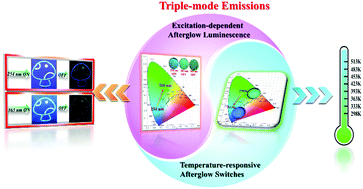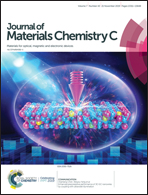Tunable afterglow luminescence and triple-mode emissions of thermally activated carbon dots confined within nanoclays†
Abstract
Carbon dots (CDs) as newly emerged afterglow materials have attracted extensive interest owing to their numerous merits (e.g., such as low toxicity, excellent biocompatibility, low cost and facile preparation), yet most CDs are generally restricted to dual-mode emissions (such as blue fluorescence and green phosphorescence). Herein, we provide a facile and universal approach to achieve tunable afterglow luminescence and interesting multi-mode emissions (fluorescence (FL), delayed fluorescence (DF), and room-temperature phosphorescence (RTP)) through in situ formation and covalently fixing carbon dots (CDs) on the layer of clay (CDs@clay) induced by thermal treatment. The multi-mode emissions are mainly activated by the n → π* transitions of C![[double bond, length as m-dash]](https://www.rsc.org/images/entities/char_e001.gif) O with a conjugated aromatic group and the covalent bond formation between CDs and clay sheets. It is noteworthy that the afterglow emission (DF and RTP) switching can be achieved via excitation wavelength and temperature variations, which strongly depend on whether the electrons are directly excited to the excited state S2 or S1 state. Such excellent properties allow CDs@clay to show promising application in the advanced multicolor-encoded and multiple-mode-integrated optical anti-counterfeiting and sensing fields.
O with a conjugated aromatic group and the covalent bond formation between CDs and clay sheets. It is noteworthy that the afterglow emission (DF and RTP) switching can be achieved via excitation wavelength and temperature variations, which strongly depend on whether the electrons are directly excited to the excited state S2 or S1 state. Such excellent properties allow CDs@clay to show promising application in the advanced multicolor-encoded and multiple-mode-integrated optical anti-counterfeiting and sensing fields.



 Please wait while we load your content...
Please wait while we load your content...